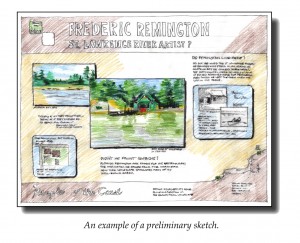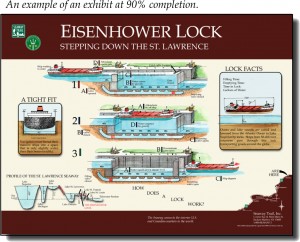Environmental Interpretation is the name given to the profession that presents information on site resources in the form of exhibits consisting of a combination of text and graphics, among other types of exhibits and programs. Most everyone has visited a State or National Park or other recreation area and seen these outdoors exhibits, also called ‘storyteller signs.’ They explain aspects of the natural, cultural, or historical features of a landscape or artifact.
Bob’s background in art and Landscape Architecture has prepared him to deliver a full service package from interpretive design, writing, original art, photography, graphic design, digital files, to installation details. He has designed 150 storyteller signs for the 458 mile Great Lakes Seaway Trail National Scenic Byway. He has also designed outdoor and indoor exhibits for The Nature Conservancy, the Open Space Institute, SUNY College of Environmental Science and Forestry, NY Sea Grant, NYS Department of Environmental Conservation, the Tug Hill Tomorrow Land Trust, the Finger Lakes Land Trust, the Thousand Islands Land Trust, the Onondaga County Museum of Science and Technology, and many other organizations.
Design Process
The process used for designing interpretive exhibits is a step by step process that invites continuous client input. The first step is to meet on site with the local client group and introduce ourselves to the resource and the stakeholders.
We observe and photograph the resource, search available documents and photos, and interview site people with knowledge of the topic. We listen to the ideas presented by the local stakeholders and experts, encourage them to focus on a theme and help them prioritize the major topics to be addressed within the theme.
 Based on the impressions, ideas, and data gathered from the site search, we produce a sketch of the preliminary layout and draft text. We revisit the site and present the sketch to the local stakeholders and client group. The second visit and presentation of the preliminary sketch is key to productivity. The visit allows us to confirm with the group that we are heading in the right direction, and we are able to obtain any missing information that has become evident in developing the preliminaries. Following the presentation, comments and suggestions are incorporated and production of final artwork and digital files begins. An example of a preliminary sketch is shown to the right.
Based on the impressions, ideas, and data gathered from the site search, we produce a sketch of the preliminary layout and draft text. We revisit the site and present the sketch to the local stakeholders and client group. The second visit and presentation of the preliminary sketch is key to productivity. The visit allows us to confirm with the group that we are heading in the right direction, and we are able to obtain any missing information that has become evident in developing the preliminaries. Following the presentation, comments and suggestions are incorporated and production of final artwork and digital files begins. An example of a preliminary sketch is shown to the right.
In some cases, if the client does not already have graphic design standards for interpretive exhibits, as part of the preliminary design phase we design a template for the arrangement of graphic elements, type styles and hierarchy, and other components that unify the interpretive presentation. The template contains sufficient common elements and consistency to be recognized from a distance as the brand of the organization, yet it is flexible enough to allow variations in the layout of the graphic devices and text blocks in the field of the panel.
 Once we receive verification that the design is headed in the right direction, we create the actual artwork, including line drawings, paintings, photographs, and/or reproductions of historic materials, scan them and imported into a publishing program. Text is further refined and placed in the digital publication. The refined composition, representing around 90% completion, is printed and presented as a final proof.
Once we receive verification that the design is headed in the right direction, we create the actual artwork, including line drawings, paintings, photographs, and/or reproductions of historic materials, scan them and imported into a publishing program. Text is further refined and placed in the digital publication. The refined composition, representing around 90% completion, is printed and presented as a final proof.
After any revisions required by the final check are incorporated, a package including a disk and final small scale digital guide print is prepared for the manufacturer. We review press proofs from the manufacturer and work with them to coordinate our settings and achieve the expected outcome.
Materials
Recent developments in outdoor signage technology have produced a material that is weather and vandal resistent, and can contain full color images without paying a premium. The substrate is a material that is generically called high pressure laminate, the image is printed on a special paper that is embedded in phenolic resin, built up to the desired thickness with additional laminations, and fused into an integral mass under high pressure and heat. The material can be cut and machined like wood and is fade and impact resistent. The best part is that the cost has dropped dramatically from earlier methods of producing full color exterior panels. There are a few companies around the country that produce this type of panel, to find them search keywords “high pressure laminate signs.”
Project Portfolio
View Bob’s environmental interpretation project portfolio here.



